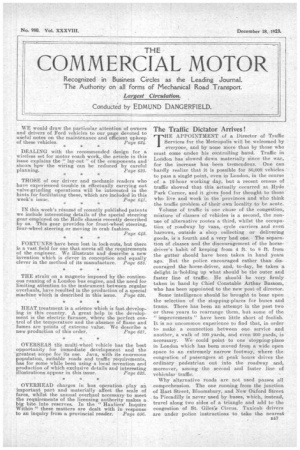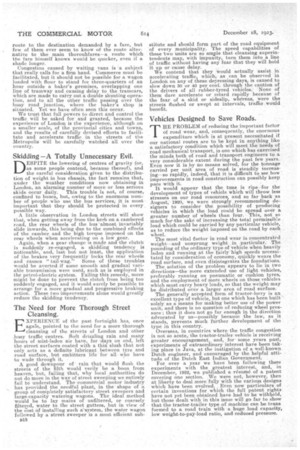The Traffic Dictator Arrives!
Page 1

Page 2

If you've noticed an error in this article please click here to report it so we can fix it.
THE APPOINTMENT of a Director of Traffic Services for the Metropolis will be welcomed by everyone, and by none more than by those who must come under his controlling hand. Traffic in London has slowed down materially since the war, for the increase has been tremendous. One can --hardly realize that it is possible for 56,000 vehicles to pass a single point, even in London, in the course of a 12-hour working day, but a recent census of traffic showed that this actually occurred at Hyde Park Corner, and it gives food for thought to those" who live and work in the provinces and who think the traffic problem of their own locality to be acute.
Volume of traffic is one cause of the congestion, mixture of classes of vehicles is a second, the nonuse of alternative routes a third, whilst the occupation of roadway by vans, cycle carriers and even barrows, Outside a shop collecting or delivering goods, is a fourth and a very bad one. The separation of classes and the discouragement of the horsedriver's habit of keeping from 4 ft. to 8 ft. from the gutter should have been taken in hand years ago. .But the police encouraged rather than discouraged the horse-driver, and, to-day, be takes a delight in-holding up what should be the outer and faster line of traffic. He should be very firmly taken in hand by Chief Constable Arthur Bassom, who has been appointed to the new post of director.
Some intelligence should be brought to bear upon the selection of the stopping-places for buses and trams. There has been an attempt in the past two or three years to rearrange them, but some of the " improvernents " have been little short of foolish. It is no uncommon experience to find that, in order to make a connection between one service and another, a walk of 100 yards, and even 200 yards, is necessary. We could point to one stopping-place in London which has been moved .frorn a wide open space to an extremely narrow footway, where the congestion of passengers at peak hours drives the ordinary pedestrian out into the roadway and, moreover, among the sec-end and faster line of vehicular traffic.
Why alternative roads are not used passes all comprehension. The one running from the junction of Hart Street, Bloomsbury, and New Oxford Street to Piccadilly is never used by buses, which, instead, travel along two sides of a triangle and add to the congestion of St. Giles' i Circus. Taxicab drivers are under police instructions to take the nearest route to the destination demanded by a fare, but few of them ever seem to know of the route alternative to the main thorouhfares—a route which the fare himself knows would be quicker, even if a shade longer. . Congestion caused by waiting vans is 'a subject that really calls for a firm hand. Commerce must be facilitated, but it should not be popsible for a wagon loaded with flour to stand for three-quarters of an hour outside a baker's premises, overlapping one line of tramway and causing delay to the tramcars, which are made to carry out a double shunting operation, and to all the other traffic passing over the busy road junction, where the baker's shop is situated. Yet we have often seen this occur.
We trust that full powers to direct and control the traffic will be asked for and granted, because the experience of London is the experience, although on a smaller scale, of the provincial cities and towns, and the results of carefully devised efforts to facilitate and accelerate traffic in the streets of the Metropolis will he carefully watched all over the country.
Skidding —A Totally Unnecessary Evil.
DESPITE the lowering of centres of gravity (or. as some people contend, because thereof), and the careful consideration given to the distribution of weight in bus chassis, the fact 'remains that, under the weather conditions now obtaining in London, an alarming number of more or less serious
Aidsoccur daily. This trouble is not, of course, confined to buses, hut, owing to the enormous number of people who use the bus services; it is most important that they should be protected in every possible way.
A little observation in London streets will show that, when getting away from the kerb on a cambered road, the rear wheels of the bus 'almost invariably slide inwards, this being due to the combined effects of the camber and the high torque imposed on the rear wheels when accelerating on a low gear. Again when a gear change is made and the clutch is suddenly . re-engaged, a skidding tendency is noticeable, and, last but not least, the application of the brakes very frequently locks the rear wheels and causes " tail-wag." Some of these troubles would be averted if some smooth and gradual variable transmission were used, such as is employed in the petrol-electric system. Failing this remedy, more might be done to prevent the clutch from being too suddenly engaged, and it would surely be possible to arrange for a more gradual and progressive braking action. These two improvements alone would greatly reduce the skidding tendency.
The Need for More Thorough Street Cleansing.
E
. XPERIENCE of the past fortnight has, once again, pointed to the need for a more thorough cleansing of the streets of London and other .busy traffic centres. Soft drizzling rain and many hours of mist-laden air have, for • days on end, left the street surfaces coated with a thin slush that not only acts as a definite lubricant between tyre and road surface, but embitters life for all who have to wade through it. • A good downpour of rain that would flush the streets of the filth would verily be a boon from heaven, but, failing that, why local authorities do not do more in the way of street sweeping we entirely fail tO understand. The 'commercial motor industry has provided the needful plant, in the shape of a group of eonipletely satisfactory street sweepers and large-capacity watering wagons. The ideal method would be to lay mains of unfiltered, or coarsely filtered, water to the street gutters, but in view of the cost Of installing such a'system, the water wagon followed by a street sweeper is a most efficient sub B18 stitute and should form part of the road equipment of every municipality. The speed capabilities of these 'two units are so ample that cleansing superintendents may, with impunity, turn them into a line of traffic without having any fear that they will hold it up or cause delay. We contend that they would actually assist in accelerating traffic, which, as can be observed in London on any of these depressing days, is caused to slow down 30 or 40 per cent. through the caution of the drivers of all rubber-tyred vehicles: None of them dare accelerate or retard rapidly because of the fear of a, skid or sideslip, whereas, were the streets flushed or swept at intervals, traffic would benefit.
Vehicles Designed to Save Roads.
HE PROBLEM of reducing the important factor of road wear, and, consequently, the enormous
expenditure which is at present necessitated if our national routes are to be kept in anything like a satisfactory condition which will meet the needs of road mechanical transport, is one which has exercised the minds both of road and transport engineers to a very considerable extent during the past few years.
Even now it is by no means solved, for the tonnage carried per unit area of road is steadily increasing—so rapidly, indeed, that it is difficult to .see how improvem,ents in road. construction can possibly keep pace with it.
It would appear that the time is ripe -for the development of types of vehicle which will throw less stresses on our road resources, and so far back as August, 1920, we were strongly recommending designers to consider the possibility of producing vehicles in which the load could be spread over a greater number of wheels than four. This, not so much for the sake of increasing the total permissible load which could be carried by any particular vehicle, as to reduce the weight imposed on the road by each wheel.
The most vital factor in road wear is concentrated weight—and unsprung weight in particular. The pounding of the ordinary type of vehicle when heavily laden and running at the fairly high speeds necessitated by consideration of economy, quickly wears the
road surface, and even disintegrates the foundations.
The solution of the problem appears to lie in two directions—the more extehded use of light vehicles, preferably running on pneumatic or cushion tyres, and the employment of more wheels on those vehicles which must carry heavy loads, so that the weight may be distributed over a larger area of road surface. The generally accepted form of tractor-lorry is an excellent type of vehicle, but one which has been built' solely as a means for making better use of the power unit, and there is no question of redocing wheel pres sure; thus it does not go far enough in the direction advocated by us—possibly because the law, as it stands, prevents much further development of the type in this country.
Overseas, in countries where the traffic congestion is not so acute, the tractor-trailer vehicle is receiving
greater encouragement, and, for some years past, xperiments a extraordinary interest have been takng place in Java, at the instigation of a well-known Dutch engineer, and encouraged by the helpful attiude of the Dutch East Indian Government.
For over a year we have been following these experiments with the greatest interest, and, in December, 1922, we published a résumé of a patent covering one section. We were not, however, then at liberty to deal more fully with the various designs which have been evolved. Even now particulars of ertain inventions for which the full patent rights have not yet been obtained have had to he withheld, but those dealt with in this issue will go far to show hat the tractor-trailer type of machine can be trans ormed to a road train with• a huge load capacity, ow weight-to-pay-load ratio, and reduced pressure.






























